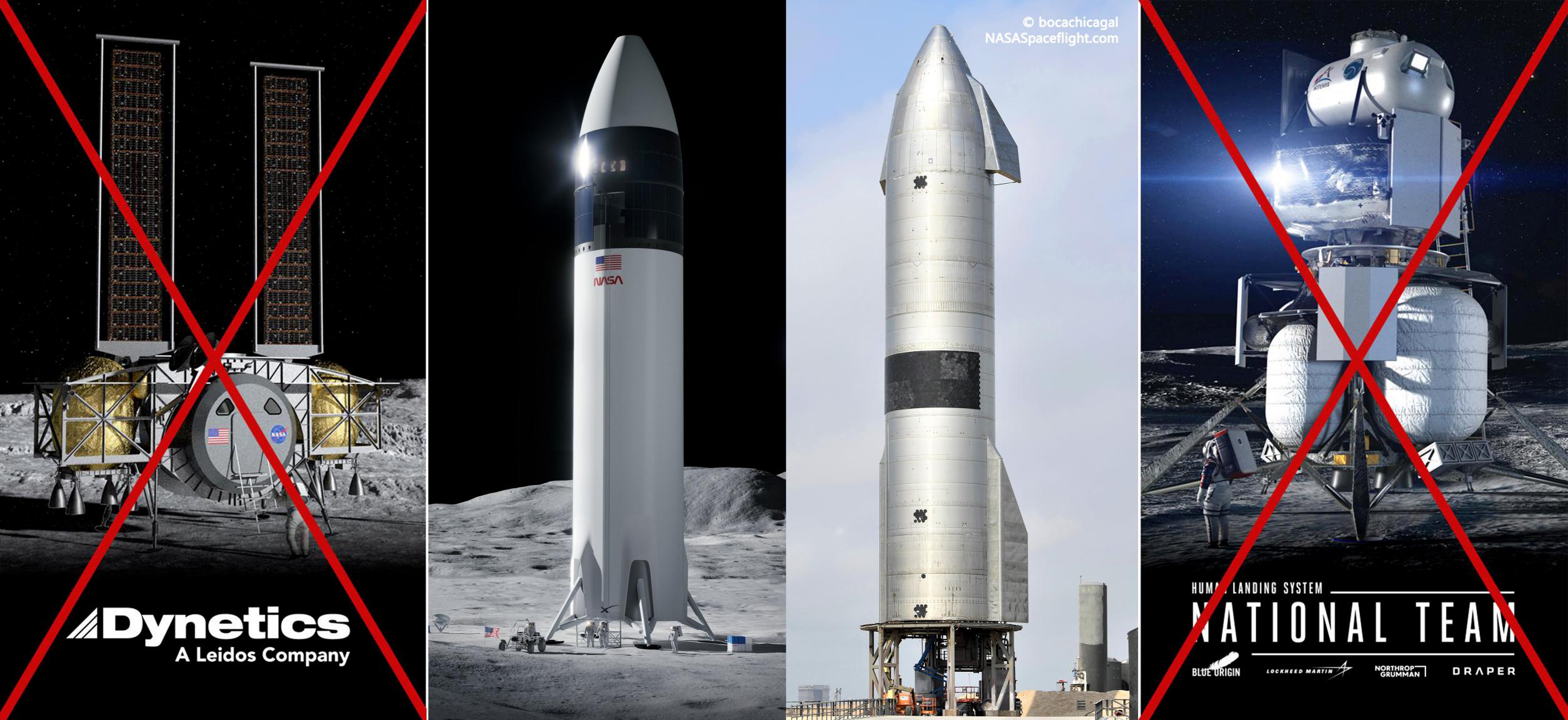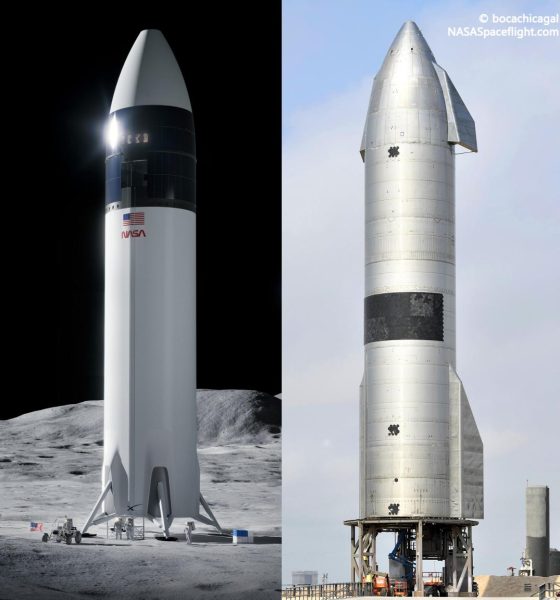

News
SpaceX’s Starship Moon lander under fire yet again as Blue Origin sues NASA
Less than three weeks after the US Government Accountability Office (GAO) categorically denied protests from Blue Origin and Dynetics over NASA’s decision to award SpaceX a Moon lander development contract, the former company has sued the space agency.
First reported by The Verge, Blue Origin filed its lawsuit against NASA with the US Court of Federal Claims on Monday, August 16th and continues to spout the same kind of rhetoric that GAO wholeheartedly refuted on July 30th. Namely, the office explicitly upheld the procurement process and reasoning behind NASA’s decision to award SpaceX – and SpaceX alone – a contract to develop a crewed Moon lander.
Thus far, the central argument put forth by Blue Origin and Dynetics is that NASA effectively invalidated the entire Human Landing System (HLS) “Option A” procurement when it didn’t award two HLS development contracts. Option A refers to a limited portion of the HLS program focused on funding the development of crewed Moon landers and the completion of two crucial flight tests – one uncrewed and one with NASA astronauts aboard.
Program-wise, HLS is quite similar to NASA’s Commercial Crew Program (CCP), which began as a series of smaller contracts focused on capability demonstrations that culminated in a major competition to ferry NASA astronauts to and from the International Space Station (ISS). Ultimately, NASA selected Boeing and SpaceX and the rest is now history (SpaceX flourished; Boeing floundered) and despite unsurprising delays, the program has been an extraordinary success and a financial bargain.
As part of the major Commercial Crew Transportation Capability contracts SpaceX and Boeing won, both companies were tasked with designed, building, and qualifying crewed spacecraft to NASA specifications. The centerpiece of those contracts was a pair of full-up demonstration flights to and from the ISS – one uncrewed and the other with two NASA astronauts. NASA then separately purchased “post-certification missions” – operational crew transport flights – from both companies a few years into development.
The corollaries between Commercial Crew and HLS are clear and unsurprising. However, unlike the Commercial Crew Program, NASA has been able to structure HLS with the benefits of hindsight. This time around, already faced with a Congressional funding shortfall even worse than years of half-funding that directly delayed CCtCap, NASA used a different procurement ‘vessel’ for HLS and repeatedly warned competitors that while it wanted two Moon lander providers, the ability to award two contracts would be entirely dependent on funding availability.
In other words, NASA had learned an important lesson from the Commercial Crew Program and wasn’t about to trap itself with contractual obligations that far outmatched recent Congressional funding trends. Intentionally or not, NASA structured HLS in such a way that it only awarded major Option A lander contracts after Congress had already appropriated its FY2021 funding. As it turned out, Congress ultimately provided a pathetic 25% of the full $3.4 billion NASA had requested, leaving the agency no choice but to downselect to just a single provider – SpaceX. Put simply, NASA has assumed that Congress will continue to supply just a tiny fraction of the funding it would need to develop two landers on time and SpaceX’s Starship proposal was just cheap enough to make any Option A award possible.
The fixed-price contract will cost NASA $2.9B over four or so years – narrowly within the space agency’s reach if Congress continues to appropriate around $850M annually ($3.4B over four years). The numbers are very simple. As GAO notes, the Broad Agency Announcement (BAA) vehicle NASA used for its HLS Option A procurement also strictly allows the agency to select as many or as few proposals as it wants, including none at all. In the lead-up to proposal submission, official NASA documents repeatedly cautioned as much, warning that the agency might not even award one contract depending on funding or the quality of proposals it received.
For Blue Origin’s lawsuit to succeed, the increasingly desperate company will have to convince a federal judge that basic realities and longstanding precedents of federal procurement – not just NASA’s HLS award to SpaceX – are flawed and need to be changed. The odds of success are thus spectacularly low. However, if the presiding judge allows the case to proceed and awards Blue Origin an injunction against NASA, it could force the space agency to cease work on SpaceX’s HLS contract for months and potentially freeze SpaceX’s access to the $300M NASA recently disbursed.

Elon Musk
Elon Musk and Tesla AI Director share insights after empty driver seat Robotaxi rides
The executives’ unoccupied tests hint at the rapid progress of Tesla’s unsupervised Robotaxi efforts.

Tesla CEO Elon Musk and AI Director Ashok Elluswamy celebrated Christmas Eve by sharing personal experiences with Robotaxi vehicles that had no safety monitor or occupant in the driver’s seat. Musk described the system’s “perfect driving” around Austin, while Elluswamy posted video from the back seat, calling it “an amazing experience.”
The executives’ unoccupied tests hint at the rapid progress of Tesla’s unsupervised Robotaxi efforts.
Elon and Ashok’s firsthand Robotaxi insights
Prior to Musk and the Tesla AI Director’s posts, sightings of unmanned Teslas navigating public roads were widely shared on social media. One such vehicle was spotted in Austin, Texas, which Elon Musk acknowleged by stating that “Testing is underway with no occupants in the car.”
Based on his Christmas Eve post, Musk seemed to have tested an unmanned Tesla himself. “A Tesla with no safety monitor in the car and me sitting in the passenger seat took me all around Austin on Sunday with perfect driving,” Musk wrote in his post.
Elluswamy responded with a 2-minute video showing himself in the rear of an unmanned Tesla. The video featured the vehicle’s empty front seats, as well as its smooth handling through real-world traffic. He captioned his video with the words, “It’s an amazing experience!”
Towards Unsupervised operations
During an xAI Hackathon earlier this month, Elon Musk mentioned that Tesla owed be removing Safety Monitors from its Robotaxis in Austin in just three weeks. “Unsupervised is pretty much solved at this point. So there will be Tesla Robotaxis operating in Austin with no one in them. Not even anyone in the passenger seat in about three weeks,” he said. Musk echoed similar estimates at the 2025 Annual Shareholder Meeting and the Q3 2025 earnings call.
Considering the insights that were posted Musk and Elluswamy, it does appear that Tesla is working hard towards operating its Robotaxis with no safety monitors. This is quite impressive considering that the service was launched just earlier this year.
Elon Musk
Starlink passes 9 million active customers just weeks after hitting 8 million
The milestone highlights the accelerating growth of Starlink, which has now been adding over 20,000 new users per day.

SpaceX’s Starlink satellite internet service has continued its rapid global expansion, surpassing 9 million active customers just weeks after crossing the 8 million mark.
The milestone highlights the accelerating growth of Starlink, which has now been adding over 20,000 new users per day.
9 million customers
In a post on X, SpaceX stated that Starlink now serves over 9 million active users across 155 countries, territories, and markets. The company reached 8 million customers in early November, meaning it added roughly 1 million subscribers in under seven weeks, or about 21,275 new users on average per day.
“Starlink is connecting more than 9M active customers with high-speed internet across 155 countries, territories, and many other markets,” Starlink wrote in a post on its official X account. SpaceX President Gwynne Shotwell also celebrated the milestone on X. “A huge thank you to all of our customers and congrats to the Starlink team for such an incredible product,” she wrote.
That growth rate reflects both rising demand for broadband in underserved regions and Starlink’s expanding satellite constellation, which now includes more than 9,000 low-Earth-orbit satellites designed to deliver high-speed, low-latency internet worldwide.
Starlink’s momentum
Starlink’s momentum has been building up. SpaceX reported 4.6 million Starlink customers in December 2024, followed by 7 million by August 2025, and 8 million customers in November. Independent data also suggests Starlink usage is rising sharply, with Cloudflare reporting that global web traffic from Starlink users more than doubled in 2025, as noted in an Insider report.
Starlink’s momentum is increasingly tied to SpaceX’s broader financial outlook. Elon Musk has said the satellite network is “by far” the company’s largest revenue driver, and reports suggest SpaceX may be positioning itself for an initial public offering as soon as next year, with valuations estimated as high as $1.5 trillion. Musk has also suggested in the past that Starlink could have its own IPO in the future.
News
NVIDIA Director of Robotics: Tesla FSD v14 is the first AI to pass the “Physical Turing Test”
After testing FSD v14, Fan stated that his experience with FSD felt magical at first, but it soon started to feel like a routine.

NVIDIA Director of Robotics Jim Fan has praised Tesla’s Full Self-Driving (Supervised) v14 as the first AI to pass what he described as a “Physical Turing Test.”
After testing FSD v14, Fan stated that his experience with FSD felt magical at first, but it soon started to feel like a routine. And just like smartphones today, removing it now would “actively hurt.”
Jim Fan’s hands-on FSD v14 impressions
Fan, a leading researcher in embodied AI who is currently solving Physical AI at NVIDIA and spearheading the company’s Project GR00T initiative, noted that he actually was late to the Tesla game. He was, however, one of the first to try out FSD v14.
“I was very late to own a Tesla but among the earliest to try out FSD v14. It’s perhaps the first time I experience an AI that passes the Physical Turing Test: after a long day at work, you press a button, lay back, and couldn’t tell if a neural net or a human drove you home,” Fan wrote in a post on X.
Fan added: “Despite knowing exactly how robot learning works, I still find it magical watching the steering wheel turn by itself. First it feels surreal, next it becomes routine. Then, like the smartphone, taking it away actively hurts. This is how humanity gets rewired and glued to god-like technologies.”
The Physical Turing Test
The original Turing Test was conceived by Alan Turing in 1950, and it was aimed at determining if a machine could exhibit behavior that is equivalent to or indistinguishable from a human. By focusing on text-based conversations, the original Turing Test set a high bar for natural language processing and machine learning.
This test has been passed by today’s large language models. However, the capability to converse in a humanlike manner is a completely different challenge from performing real-world problem-solving or physical interactions. Thus, Fan introduced the Physical Turing Test, which challenges AI systems to demonstrate intelligence through physical actions.
Based on Fan’s comments, Tesla has demonstrated these intelligent physical actions with FSD v14. Elon Musk agreed with the NVIDIA executive, stating in a post on X that with FSD v14, “you can sense the sentience maturing.” Musk also praised Tesla AI, calling it the best “real-world AI” today.








